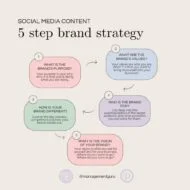Posted by Managementguru in How To, Instagram Marketing, Marketing, Online Shopping, Social Media
on May 17th, 2024 | 0 comments

In the dynamic world of social media, Instagram continues to be a powerhouse with 2 billion active monthly users as of late 2023. As easy as the idea might sound, it sure needs a strategic approach backed up by information related to the latest platform trends and user behaviors. Understanding the Landscape Instagram is the third most-used social platform globally, with users hooked to Reels, which account for 20% of in-app activity. With only 0.1% of users exclusive to Instagram, cross-platform promotion is essential. Content is King Quality content reigns supreme. In 2024, Instagram’s algorithm continues to favor video content, especially Reels. However, don’t neglect other formats; a mix of Reels, Stories, and traditional posts can broaden your reach. Engagement Drives Growth Interaction is crucial. Respond to comments, engage with similar accounts, and use relevant hashtags to increase visibility. The average monthly growth for business accounts is +1.25%—aim to surpass this by fostering a community around your brand. Strategic Posting Timing matters. Analyze your audience’s online habits and post accordingly to maximize engagement. Consistency in posting frequency also helps maintain visibility in followers’ feeds. Collaboration and Ads Partner with influencers and brands to tap into new audiences. Additionally, consider Instagram ads to boost your profile’s exposure to targeted demographics. Analytics and Adaptation Regularly review your account’s performance. Instagram’s analytics tools provide insights that can guide content strategy and posting schedules. Conclusion Growing to 100k followers requires a blend of high-quality content, consistent engagement, strategic collaborations, and data-driven adjustments. By staying adaptable and leveraging Instagram’s evolving features, you can expand your reach and build a robust following in...

Posted by Managementguru in How To, Instagram Marketing, Marketing, Social Media
on May 14th, 2024 | 0 comments

Instagram reels are a great way to reach audience outside of your current followers. They are catchy, memorable and easy to share, hence serve as an organic way to reach new audience. 1. Product Showcase Exhibit your products in a visually appealing manner. Highlight their features and benefits. Go for close ups, animations and text overlays to capture your audiences’ attention. 2. Product Reviews and Unboxing Unboxing of a product is always a treat to watch. Do it in style by highlighting the product features along with a great review through voice over in the background. 3. Stop Motion Animation Create stop motion animation of your products in action or tell a story related to your business or service using attractive props. 4. Customer Testimonials Testimonials from genuine customers go a long way in building trust among the new customers. Compile text or voice over customer testimonials and reviews along with enchanting visuals of your products. 5. User Generated Content Share reels featuring customer or client using your product or service, ofcourse with their consent. This will definitely spark an interest in the viewers’ mind and instigate them to explore your profile further. 6. How to Guides A clear-cut demo of how to use your product or offering some helpful tips & tricks related to your industry can do the magic. 7. Mini Documentaries Create a small documentary style video about your brand’s history, values, vision or a specific aspect of your business. 8. Infographics and Data Visualisation Use text and animations to visualise data, statistics or interesting real time facts relevant to your industry. 9. Trending Content Invite your audience to participate in trending challenges to give your business a better exposure. Incorporate your products or services creatively. Follow us on Instagram Managementguru...

Posted by Managementguru in Branding, How To, Marketing, Sales, SEO, Social Media
on May 5th, 2024 | 0 comments

I would like to list 7 key metrics for you to understand how Instagram algorithm has changed and how it works now in 2024. This will help you in focusing on what needs to be done with some clarity. Lets go. Hashtags ruled the kingdom, but now… I know we all went bald in an effort to catch hold of the right hashtags to take our posts/content in front of the right audience. But now hashtags take a back seat – while still they play a pivotal role in reaching the target audience , you need not scramble for 30 hashtags. Instagram advises creators to use between 3-5 hashtags on their posts. A later study has revealed that the highest count need not surpass 20. Captions weren’t crucial but now… Engaging captions are very important when it comes to Instagram as they increase interactions and are your key to discoverability. A strong caption will lure your audience compelling them to look what you have to offer in your reel / story/post. Negative captions sometimes work best for you. SEO had minimal impact but now… SEO keywords are growth game changers. The better your SEO game, the better the algorithm matches users’ queries with your content. One-type content was popular, but now… Using multiple content formats like reels, stories, carousel posts, live intreactions make people want more of your stuff. You have to make them feel your personal/business brand’s presence consistently yet subtly. Collaborations fell flat but now… Collaborations or Brand partenerships are the vibe of the day. If you are able to pitch your request for sponsorship bang-on, you are a winner. It all boils down how you have structured your Instagram account, your niche and follower count. Sometimes “follower count factor” becomes completely nullified if you have amazing skills that the sponsor needs. Follower count was the obsession but now… Community engagement is the new focus. You must be able to keep the visitors in your channel /page longer. For this to happen, you should have friendly chit chat with your followers, DM to their queries immediately, even visit their accounts and show your appreciation in return. Likes were the growth metric, but now… Saves and shares are the KPI’s when you want to gauge the success of your work on Instagram. The more your content is saved and shared the more is your reach. The ROI is practically measurable in this platform through the insights. How to “Beat” the Instagram Algorithm in 2024 #1: Consistently Share Instagram Reels #2: Encourage More Interactions with Instagram Stories Stickers #3: Drive Conversations with Engaging Captions #4: Add Hashtags and Keywords to Your Posts #5: Ask Followers To Add You to Their Favorites Feed #6: Cross-promote Your Instagram Content #7: Use Instagram Analytics to See What’s...

Posted by Managementguru in How To, Marketing, Pinterest Hacks, Social Media
on Apr 4th, 2024 | 0 comments

Form a clear plan as to what’s your brand’s purpose, what are the brand values, who is your brand for, how it is different from other brands and your vision. This brand definition and content strategy will give you a clear idea on the Do’s and Don’ts of Social Media in order to increase and retain your followers count as well DO’s DO keep your branding consistent across all of your social media channels. DO keep your messaging consistent to keep your followers interested. DO make use of social media advertising DO share valuable content that is relevant with your business and in line with your objectives. DO set clear goals and objectives & analyze activity. MAKE sure your posts are funny and engaging. MAKE sure to include relevant hashtags to help increase post reach. MAKE sure to respond to comments and questions – spend 15 to 30 minutes after posting responding and continue the conversation. Start posting with purpose – content strategy is important. DONT’ s DON’T overdo it. 46% of social media followers will unfollow a brand for posting too many promotional messages. DON’T use engagement bait tactics. DON’T use all social media platforms for the sake of it – Know your audience. DON’T get hungry up on numbers. The real value of social media is found in the amount of engagement you’re receiving and the type of people you’re receiving it from. Focus on these figures instead. DON’T post too often or you’ll annoy your followers. DON’T post something that’s not valuable, engaging or funny. DON’T include irrelevant hashtags or too many hashtags. DON’T forget to post regularly or you’ll lose your followers’ interest. DON’T display a bad attitude online – people will not respond well. DON’T be too salesy – engagement with your potential customer before you start selling. DON’T forget to thank people – if they take the time to share your...

Posted by Managementguru in E Commerce, How To, Marketing, Online Shopping, Sales, Social Media
on Mar 27th, 2024 | 0 comments

Sales occur only when you effectively influence buyers’ thoughts, emotions, logical reasoning, and decision-making processes. 18 % of the sales fail in the last step. Only 2% of the sales happen at the first meeting meaning remaining 98% of the sales occur once the buyer has built up certain level of trust in the seller. Nobody will buy anything if the person trying to sell doesn’t believe in their product. Confident salespeople are successful for a reason. Buyers need to be convinced. Show them how your solution will help them achieve their desired outcome. Tip #1 Instead of waking up thinking, “I need to close X sales”, you should think, “I need to find X people I can help today.” Feel the difference? Tip #2 It is harder for humans to make choices if we’re presented with too many options. A study found that while more variety draws us in, it fails to convert interests into purchases. So be careful, don’t overwhelm your customers. Tip #3 Creating the fear of ” missing out on a great opportunity” among customers is an oldest and still working trick to increase your sales. Tip #4 For luxury brands, ruder the sales staff, the higher the sales. Tip #5 Some products lose their buying value if they are put on a discount or an offer. They have an upward sloping demand curve & are mostly looked upon as status symbol. These are called Veblen goods and this psychological effects is called the veblen effect. Tip #6 Drinking coffee before shopping results in spree buying. Infact caffeinated drinks trigger “energetic arousal” in us and increase purchase intentions for hedonic products such as buttery, salty popcorn, chocolate candy and luxury vacation. Well, see to it a coffee shop is nearby your store. Or offer good coffee to your customers bearing this tip in mind! Tip #7 More than 50% of the consumers will enter a store that has a “Sale” sign. Tip #8 60% are more likely to buy if the word “guaranteed” is associated with their purchase. Tip #9 90% of people said positive online reviews influenced them to buy.25% are more likely to buy if they received follow up information on a product. Tip #10 Customers like “consistency” but they also like surprises. Majority of global consumers are likely to switch brands to one associated with good cause. Dont sell logic, sell emotions and desires Dont let your prospect lead the conversation. Push emotional triggers and find out where it hurts. Use powerful words and build massive certainty in customer’s...










